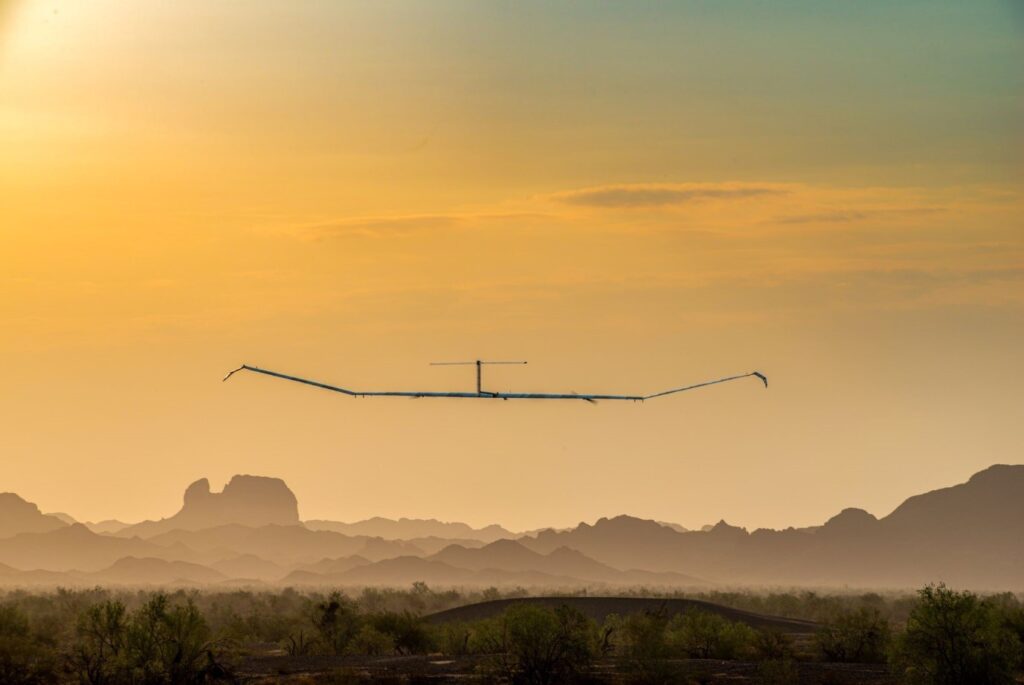
The new HAPS connectivity services business launched by Airbus during Farnborough will operate as a subsidiary of Airbus Defence and Space. (Photo, courtesy of Airbus)
Airbus is launching a new connectivity service business around its HAPS technology platform, Zephyr, led by former Intelsat CCO Samer Halawi. The new venture, HAPS Services Business, is a subsidiary of Airbus Defence and Space.
HAPS — high altitude platform stations — operate in the stratosphere, much closer to Earth than satellites, and can provide connectivity. Zephyr is an unmanned aerial system (UAS). The Zephyr was originally developed in the early 2000s by QinetiQ, and then sold to EADS Astrium, now Airbus Defence and Space.
The current Airbus Zephyr has a wingspan of 25 meters, weighs less than 75 kilograms, and is solar powered. In 2018, the system flew a record 25 days, 23 hours and 57 minutes without refueling. The BBC recently reported that flight tracking data suggests a Zephyr recently broke the 2018 record, spending 26 days airborne, but Airbus would not comment on the test.
Airbus sees potential for HAPS to bridge the digital divide, and claims that one Zephyr has the coverage equivalent to that of 250 cell towers and can enable direct-to-device connectivity. In 2021, Airbus and NTT DOCOMO performed a test in the U.S. in which Zephyr provided a datalink during flight to simulate future direct-to-device connectivity. Tests included various bandwidths to simulate direct-to-device service from the HAPS to end users using low, nominal and high throughput.
Airbus pitches Zephyr as complementary to existing solutions. “Filling the gap between ground towers, conventional aircraft and satellites, Zephyr is positioned perfectly to complement and enhance existing infrastructure,” the company said in a description of Zephyr.
Zephyr is not just for connectivity and it can also be equipped with sensors and used for sensing purposes like border protection and environmental monitoring for crops and wildfires. It has a wide visual payload coverage of 20 by 30 km footprint.
“Our connectivity services will provide a viable alternative and complement to terrestrial and satellite-based connectivity solutions, allowing for the first time low-latency and direct-to-device connectivity across vast geographies, and economically. Our sustainable technology allows us to save and improve people’s lives whilst ensuring a better outcome for our planet,” Halawi said.
Halawi was previously CCO of Intelsat and left the company about two months before it emerged from a long Chapter 11 bankruptcy process. He has more than 20 years of experience in the satellite industry and was previous CEO of Thuraya Telecommunications.
He is joined by CFO Taz Esmail, who was most recently CFO of Meta Aerospace. She has extensive experience in the aviation, aerospace and defense sectors.
Intelsat and Airbus both joined industry group the HAPS Alliance, formed in 2020 to promote HAPS, develop common product specifications, and promote the standardization of HAPS network interoperability.
Earlier this year, Airbus began a study with NTT, DOCOMO, and SKY Perfect JSAT to examine the feasibility of HAPS-based connectivity services in a future space-based wireless connectivity ecosystem.
Airbus is not the first to try to commercialize HAPS. Google parent company Alphabet previously invested in HAPS technology through subsidiary Loon, but shuttered the business in 2021. The venture flew a Loon balloon for 321 days from May 2019 to March 2020 and developed a number of partnerships with the satellite industry, including a Telesat, but ultimately failed to develop a business model.
“Loon has been chasing the hardest problem of all in connectivity — the last billion users: The communities in areas too difficult or remote to reach,” Loon CEO Alastair Westgarth wrote in 2021. “While we’ve found a number of willing partners along the way, we haven’t found a way to get the costs low enough to build a long-term, sustainable business.”
This article was first published by Via Satellite, a sister publication to Avionics International, it has been edited, click here to view the original version.